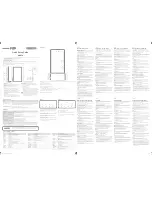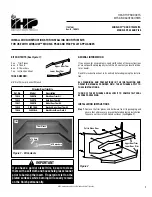
However, the road wheels may still be driving a secondary gearbox. The manufacturer will state in which drive position the secondary
gearbox should be placed, and will recommend a maximum towing speed. A towing distance and/or time limit may also be imposed by the
manufacturer.
4.4. Some four wheel vehicles are fitted with devices to disconnect the hubs and/ or driveshafts especially for towing purposes.
4.5. Consult the manufacturer’s handbook before reversing with a four wheel drive vehicle attached or a vehicle with automatic transmission.
4.6.
REMEMBER,
ALWAYS FOLLOW THE VEHICLE MANUFACTURERS RECOMMENDATIONS FOR THE VEHICLE TO BE TOWED.
5. ASSEMBLY
5.1. Remove contents from packing and check to ensure everything is correct and undamaged. Should you experience any problems contact your
supplier immediately.
5.2. Position the towing vehicle so that the distance between the towing eyes is approximately 1.6 metres.
5.3. Slide the silver tube (A) into the end of the red tube (B) and align the holes in the two components. Insert the pin (C) to hold the two tubes
together and fold down the wire clip to retain the pin. If the towing eyes on the two vehicles are not in the same plane,
turn tube (A) through 90º and insert the pin through the alternative holes on axis (XX).
5.4. Insert shackle (F) through the towing eye on the towing vehicle. Introduce tube (B) into the shackle, align the holes in the two components and
screw the shackle bolt (G) fully into position.
5.5. Insert shackle (D) through the towing eye on the vehicle to be towed and if necessary carefully adjust the distance between the two vehicles so
that shackle bolt (E ) can be inserted and screwed fully down.
6. TOWING PROCEDURE
t
6.1. TPK353 has a rolling load capacity of 2500 kgs (2.5 tonne), based on a level surface. Remember the weight of towed vehicle should be
calculated to include any load in the vehicle, and to take into account any extreme gradients.
WARNING! Before using equipment ensure you have read, understood and apply Section 1 safety instructions.
6.2.
TOWING EYES
- Many vehicle manufacturers include a separate towing eye which is not permanently fixed to the chassis.
Important: Before fitting the tow pole, to either vehicle, check the manufacturers’ handbooks to ensure that the towing points
(do not use ‘tie points’) are suitable for use with a tow pole and are capable of safely withstanding a ‘brake load’.
6.3.
LEGAL REQUIREMENTS
- It is the responsibility of the towing driver to ensure that all legal requirements are met. This includes the
towing operation and actions taken by the towed driver. Check you are insured for towing. Trade users must have a “Trade Insurance
Policy” which covers commercial towing. Note the policy will not provide cover if the law is broken, or the weight of towed load
exceeds the capacity of the tow pole, or if towed vehicle weighs more than the towing vehicle. When calculating the weight of the
towed vehicle remember that any load carried in the vehicle must be added to the kerb weight indicated in the manufacturer’s
handbook.
6.4. When towing, unlock the steering wheel and activate the warning lights on both vehicles. Ensure that the towed vehicle is in neutral, the wheels
are free to rotate, and that hand and foot brakes are disengaged.
6.5. While driving, the tow pole must remain parallel with the direction of travel, i.e. if the tow fittings are placed on different sides of the vehicles,
it will be necessary to drive out of line (the car being towed would not be directly behind the one towing). Pole must also be approximately
parallel with the road surface i.e. with the towing eyes at similar heights.
6.6. The distance between the vehicles must be enough for the driver in the towed vehicle to see the rear lights of the towing vehicle.
6.7.
A MAXIMUM SPEED OF 15MPH
should not be exceeded.
6.8. Always take great care when towing and ensure a very gradual “take-up” when starting and braking.
WARNING!
The tow pole and fittings are not able to withstand shock loads resulting from sudden changes in speed.
6.9. After use, dismantle the tow pole, clean it and store it in a dry place. Inspect regularly for signs of stress or wear. Replacement parts are not
available for this unit.
NOTE:
It is our policy to continually improve products and as such we reserve the right to alter data, specifications and component parts without prior notice.
IMPORTANT:
No liability is accepted for incorrect use of this product.
WARRANTY:
Guarantee is 12 months from purchase date, proof of which will be required for any claim.
Sole UK Distributor, Sealey Group.
Kempson Way, Suffolk Business Park,
Bury St. Edmunds, Suffolk.
IP32 7AR
www.sealey.co.uk
01284 757500
01284 703534
Web
Environmental Protection
Recycle unwanted materials instead of disposing of them as waste. All tools, accessories and packaging should be
sorted, taken to a recycling centre and disposed of in a manner which is compatible with the environment.
When the product becomes completely unserviceable and requires disposal, drain off any fluids (if applicable)
into approved containers and dispose of the product and the fluids according to local regulations.
TPK353 | Issue 3 (SP) 06/09/16
Original Language Version
© Jack Sealey Limited




















